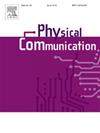On the performance of RIS-assisted energy harvesting over mixed dual-hop RF-FSO communications
IF 2
4区 计算机科学
Q3 ENGINEERING, ELECTRICAL & ELECTRONIC
引用次数: 0
Abstract
The paper examines a mixed dual-hop transmission system that uses both radio frequency (RF) and free-space optical (FSO) communication technologies. The system includes an energy-constrained source (i.e., transmitter), a decode-and-forward (DaF) relay, and a destination. The source harvests energy from a power-beacon via a reconfigurable intelligent surface (RIS) using a time-splitting protocol. The study derives closed-form expressions for the probability density functions (PDFs) and cumulative distribution functions (CDFs) of the RF and FSO links, considering charging time and the number of reflecting elements. These expressions are then used to calculate the outage probability (OP), average bit error rate (ABER), and channel capacity, with additional simplified formulas for high signal-to-noise (SNR) ratio scenarios. The paper evaluates system performance under various fading, shadowing, and turbulence conditions. Besides, the effect of pointing error, the number of reflecting elements, and the charging time is also explored. Numerical examples and Monte Carlo simulations confirm that improving turbulence conditions and reducing shadowing enhance performance, while pointing errors degrade it. Channel impairments can be mitigated by increasing reflecting elements or charging time.
求助全文
约1分钟内获得全文
求助全文
来源期刊

Physical Communication
ENGINEERING, ELECTRICAL & ELECTRONICTELECO-TELECOMMUNICATIONS
CiteScore
5.00
自引率
9.10%
发文量
212
审稿时长
55 days
期刊介绍:
PHYCOM: Physical Communication is an international and archival journal providing complete coverage of all topics of interest to those involved in all aspects of physical layer communications. Theoretical research contributions presenting new techniques, concepts or analyses, applied contributions reporting on experiences and experiments, and tutorials are published.
Topics of interest include but are not limited to:
Physical layer issues of Wireless Local Area Networks, WiMAX, Wireless Mesh Networks, Sensor and Ad Hoc Networks, PCS Systems; Radio access protocols and algorithms for the physical layer; Spread Spectrum Communications; Channel Modeling; Detection and Estimation; Modulation and Coding; Multiplexing and Carrier Techniques; Broadband Wireless Communications; Wireless Personal Communications; Multi-user Detection; Signal Separation and Interference rejection: Multimedia Communications over Wireless; DSP Applications to Wireless Systems; Experimental and Prototype Results; Multiple Access Techniques; Space-time Processing; Synchronization Techniques; Error Control Techniques; Cryptography; Software Radios; Tracking; Resource Allocation and Inference Management; Multi-rate and Multi-carrier Communications; Cross layer Design and Optimization; Propagation and Channel Characterization; OFDM Systems; MIMO Systems; Ultra-Wideband Communications; Cognitive Radio System Architectures; Platforms and Hardware Implementations for the Support of Cognitive, Radio Systems; Cognitive Radio Resource Management and Dynamic Spectrum Sharing.
 求助内容:
求助内容: 应助结果提醒方式:
应助结果提醒方式:


